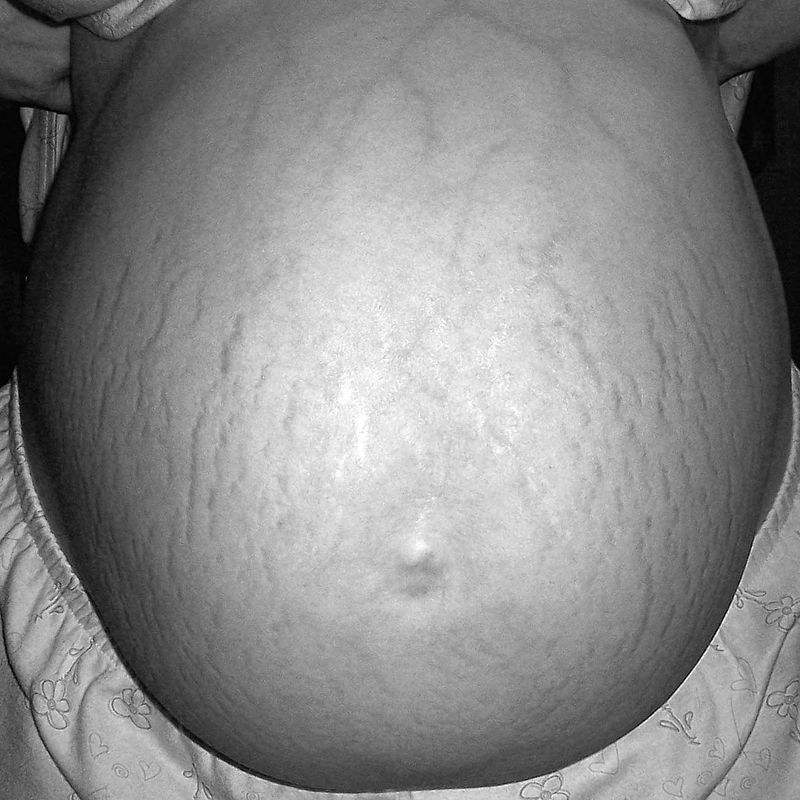Stretch marks, also known as striae, are a form of scarring on the skin with an off-color hue. Over time they may diminish, but will not disappear completely. Stretch marks formed during pregnancy, usually during the last trimester, and usually on the belly, but also commonly occurring on the breasts, thighs, hips, lower back and buttocks, are known as striae gravidarum.
Stretch marks are caused by tearing of the dermis. This is often from the rapid stretching of the skin associated with rapid growth or rapid weight changes. Stretch marks may also be influenced by hormonal changes associated with puberty, pregnancy, bodybuilding, or hormone replacement therapy.
There is no evidence that creams used during pregnancy prevent stretch marks. Once they have formed there is no clearly useful treatment though various methods have been tried.
Striae, or “stretch marks”, begin as reddish or purple lesions, which can appear anywhere on the body, but are most likely to appear in places where larger amounts of fat are stored; the most common places are the abdomen (especially near the navel), breasts, upper arms, underarms, back, thighs (both inner and outer), hips, and buttocks. Over time, they tend to atrophy and lose pigmentation. The affected areas appear empty, and are soft to the touch.
Stretch marks occur in the dermis, the resilient middle tissue layer that helps the skin retain its shape. No stretch marks will form as long as there is support within the dermis; stretching plays a role in where the marks occur and in what direction they run, however, there are a number of contributing factors (see: “Causes”, below) to their formation. They can (but do not always) cause a burning and itching sensation, as well as emotional distress. They pose no health risk in and of themselves, and do not compromise the body’s ability to function normally and repair itself, however, they are often considered a cosmetic nuisance. Young women are generally affected the most and often seek treatment for them from a dermatologist and following pregnancy.
Pregnancy stretch marks, also known as striae gravidarum, is a specific form of scarring of the skin of the abdominal area due to sudden weight gain during pregnancy. About 90% of women are affected.
A number of additional factors appear to promote the appearance of stretchmarks: one study of 324 women, done just after they had given birth, demonstrated that low maternal age, high body mass index, weight gain over 15 kg (33 pounds) and higher neonatal birth weight were independently correlated with the occurrence of striae. Teenagers were found to be at the highest risk of developing severe striae.
These off-color blemishes are symptoms of pregnancy caused by the tearing of the dermis, resulting in atrophy and loss of rete ridges. These scars often appear as reddish or bluish streaks on the abdomen, and can also appear on the breasts and thighs. Some of these striae disappear with time, while others remain as permanent discolorations of the body.
Mechanical distension and rapidly developing areas of the body during pregnancy (such as the abdomen, breasts, and thighs) are most commonly associated with striae formation. Some have suggested that relaxin and estrogen combined with higher levels of cortisol during pregnancy can cause an accumulation of muocopolysaccharides, which increases water absorption of connective tissue, making it prime for cleavage under mechanical stress. There also seems to be an association between higher body mass indices and in women with bigger babies and the incidence and severity of striae. Also, younger women seem to be at higher risk of developing striae during pregnancy.
The prevalence and severity of striae gravidarum varies among populations. The current literature suggest that in the general population of the US, there is a 50%-90% prevalence of striae associated with pregnancy, partly as a result of the normal hormonal changes of pregnancy and partly due to stretching of skin fibers. Many women experience striae gravidarum during their first pregnancy. Nearly 45% percent of women develop striae gravidarum before 24 weeks of gestation. Many women who develop lesions during the first pregnancy do not develop them during later pregnancies. Genetic factors such as family history and race also seem to be predictive in the appearance of striae.
Stretch marks. (2016, October 2). In Wikipedia, The Free Encyclopedia. Retrieved 11:34, October 2, 2016, from https://en.wikipedia.org/w/index.php?title=Stretch_marks&oldid=742220662

